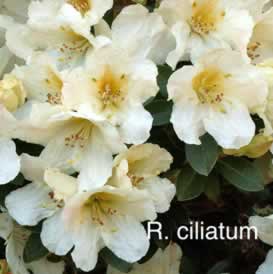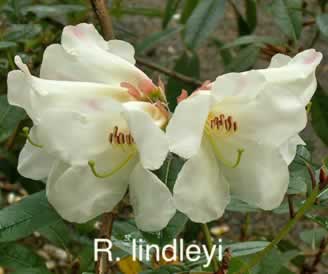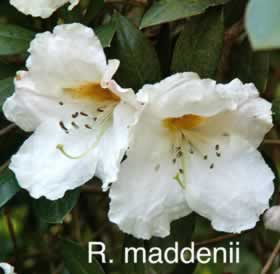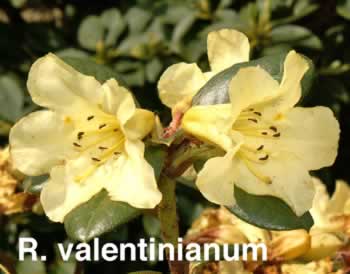
Rhododendron & Azalea News
Lepidote Rhododendrons and Leaf Scales
by Steve Henning
Valley Forge Chapter ARS
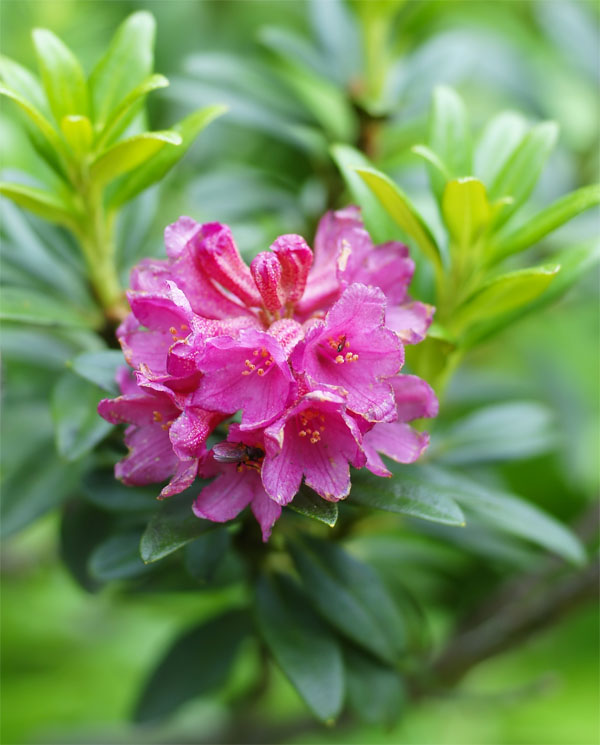
R. ferrugineum, the Alpine Rose
|
The lepidote species are characterized by the presence of scales on various parts of the plant, most obviously on the undersides of the leaves. They are generally the small-leaved species. Most lepidotes are evergreen, but some are semi-deciduous, meaning they may be deciduous in colder climates or before spring.
Most of us recognize the lepidotes as usually being smaller plants and having small, more azalea-like leaves while the elepidotes are usually larger plants and have larger leaves, including some with very large leaves. Here is where it gets messy. Though azaleas are smaller plants and have smaller leaves, they are all elepidotes. However, most of us recognize azaleas when we see them and usually don't mean to include azaleas when we say elepidotes. On the other hand, vireya rhododendrons are all lepidotes which is to be expected since they are smaller plants with smaller leaves. However, we typically don't mean to include vireyas when we say lepidotes.
The lepidote rhododendrons are the most numerous group in genus Rhododendron, with over 500 species at present recognized (though over half of these belong to the mainly Malesian section Vireya). They also have the widest ecological and geographical range. All epiphytic species are lepidote, but so too are virtually all the alpines. The northernmost rhododendron, R. lapponicum, and the southernmost, the Australian R. lochae, are both lepidotes. They are sparingly represented in North America and western Eurasia, but in Sino-Himalaya they are very numerous and are the only type of rhododendron found in the Malesian region, apart from a few exceptions. It is the lepidote species R. ferrugineum, the Alpine Rose, that botanists use to anchor or centralize the defining features of the genus Rhododendron.
The vireya tropical rhododendrons have scales, hence they are lepidote rhododendrons. This article will not deal with vireyas. However, some other tender and epiphytic lepidotes are not included in the Section Vireya such as R. edgeworthii and R. maddenii. The lepidote rhododendrons are in Genus Rhododendron, Subgenus Rhododendron, which has 3 Sections:
Lepidote Rhododendrons
| Subgenus | Section |
| Rhododendron | Pogoanthum has 10 species Rhododendron has 144 species Vireya has 319 species |
Scales - Structures found on Lepidotes and Vireyas
Map of Native Habitats of Lepidote Rhododendrons in SE Asia
Lepidote Rhododendron Species
Are you trying to tell me this plant has scales and that is good?
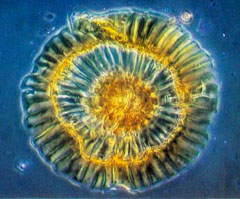 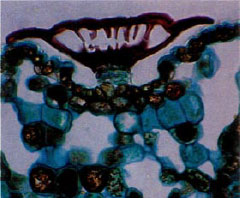 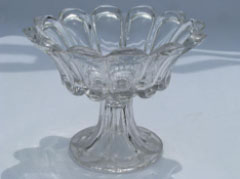 Top: Top view of a R. minus var. minus leaf scale at 300x Center: Cross-section view of the leaf scale at 300x. It reminds me of a glass compote dish (below). |
Botanists characterize lepidote rhododendrons by the presence of glandular leaf scales on various parts of the plant, mostly on the undersides of leaves. In this context scale means part of a leaf pore or stomata, and not the pesty scale insect. But what are these leaf scales that botanists talk about? I can truthfully say I have never seen one of these glandular leaf scales to know what it was. So, I went searching for pictures and I found pictures in a 1983 JARS article entitled "The Rhododendron Leaf Scale" by Clifford Desch, Jr. But the pictures were all taken with microscopes and were of structures 10 mils in diameter (.01 inches). That is about 4 times the size of a human hair, or about the size of the period at the end of this sentence. Scales are more obvious when they are dark, but sometimes they are green and blend in with the leaf. The photo shows what a scale on R. minus var. minus (carolinianum) looks like with a microscope from the top on the scale and in cross section on the right. The cross section view reminds me of a glass compote dish (below).
These glandular leaf scales are not to be confused with stomata which are the pores in the undersurface of a leaf through which oxygen, carbon dioxide, and water pass. J. M. Cowan wrote a book on rhododendron leaves in 1950: "The Rhododendron Leaf." Cowan illustrated the book with drawings showing a wide variety of leaf appendages including scales. Besides scales, other appendages include indumentum which is hair like growth and tomentum which is a waxy growth. Leaf appendages such as scale, indumentum and tomentum are called trichomes.
The ability of dense coatings of glandular leaf scales to assist in the regulation of water in leaves can enhance the ability of lepidotes to survive in severe climates. PJM is a good example of a very hardy lepidote. One lepidote, R. edgeworthii, has both scales and hairs or indumentum. The indumentum obscures the scales so R. edgeworthii is often mistaken for an elepidote. Indumentum is more common on elepidotes. Technically, the scales are glandular hairs with a complex structure. They consist of a very short stalk surrounded by a multicellular head. This is usually surrounded by a rim made up of radially arranged cells. Below are illustrations of five different types of glandular leaf scales commonly observed on rhododendrons. Each of these types of scales is unique to a different group of rhododendrons. Botanists use these miniscule features to identify and help make sense of the relationships between the approximately 1,000 rhododendron species.
Researchers have shown that some glandular leaf scales on rhododendron leaves contain an oil which prevents black vine weevils from chewing on the leaves. In studies they found that the greater the occurrence of scales was on a rhododendron's leaf, the less weevil damage it would sustain. Further research found that chemicals called terpenes were secreted from glandular leaf scales. It is these terpenes that protect the leaf from weevil damage.
But these terpenes that glandular leaf scales secrete have another function. They are secreted more in the spring and on some plants tend to form a varnish like coating over the under surface of the leaf protecting it from desiccation in the summer. Some glandular leaf scales are able to not only help regulate the secretion of water, but they take an active role in absorbing water into the plant. Absorption seems to be primarily through the cell wall. So, the scale structures complement the stomata in releasing moisture but are also able to absorb moisture.
It has been found that the presence of scales is, at least in the species examined, almost perfectly correlated with another character, namely, that the leaves are convolute in the bud, i.e., folded forward, whereas in all other groups of Rhododendron they are revolute, the margins being folded back so as to conceal most of the undersurface (J. Sinclair, Notes Roy. Bot. Gard. Edin., Vol. 19 (1937), pp. 267-71).
Botanists have classified scales into 5 different types based upon the shape of the top. They are approximately .01" or about 3 times the size of a human hair. The following diagrams are the top view and side view. As you can see, the side view is similar to that of a mushroom.
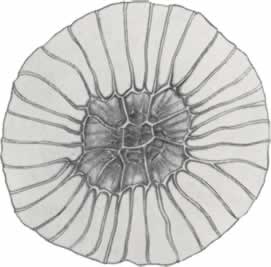 |
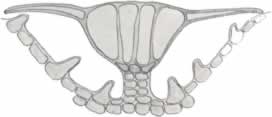 |
Entire |
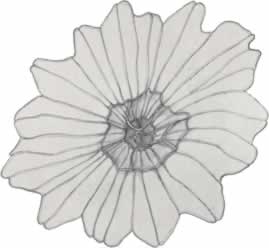 |
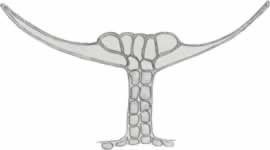 |
Lacerate |
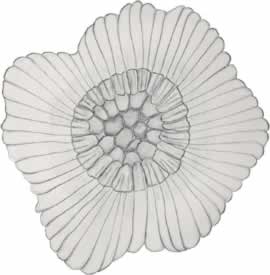 |
 |
Undulate |
 |
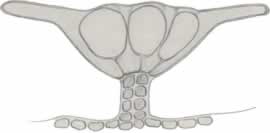 |
Crenulate |
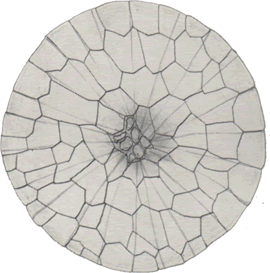 |
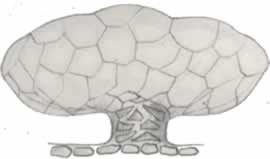 |
Vesicular |
Entire Scales: most lepidote rhododendrons and Vireyas have entire scales.
Lancerate Scales: Members of the Pogoanthym Subsection. (R. sargentianum)
Undulate Scales: Members of the Lapponica Subsection and Vaccinioides Series. (R. fastigiatum, impeditum, russatum, telmateium & vaccinioides)
Crenulate Scales: Members of the Saluenensia Subsection. (R. calostrotum & saluenense)
Vesicular Scales: Members of the Trichoclada Subsection. (R. caesium)
Map of SE Asian Native Habitats of Lepidote Rhododendrons
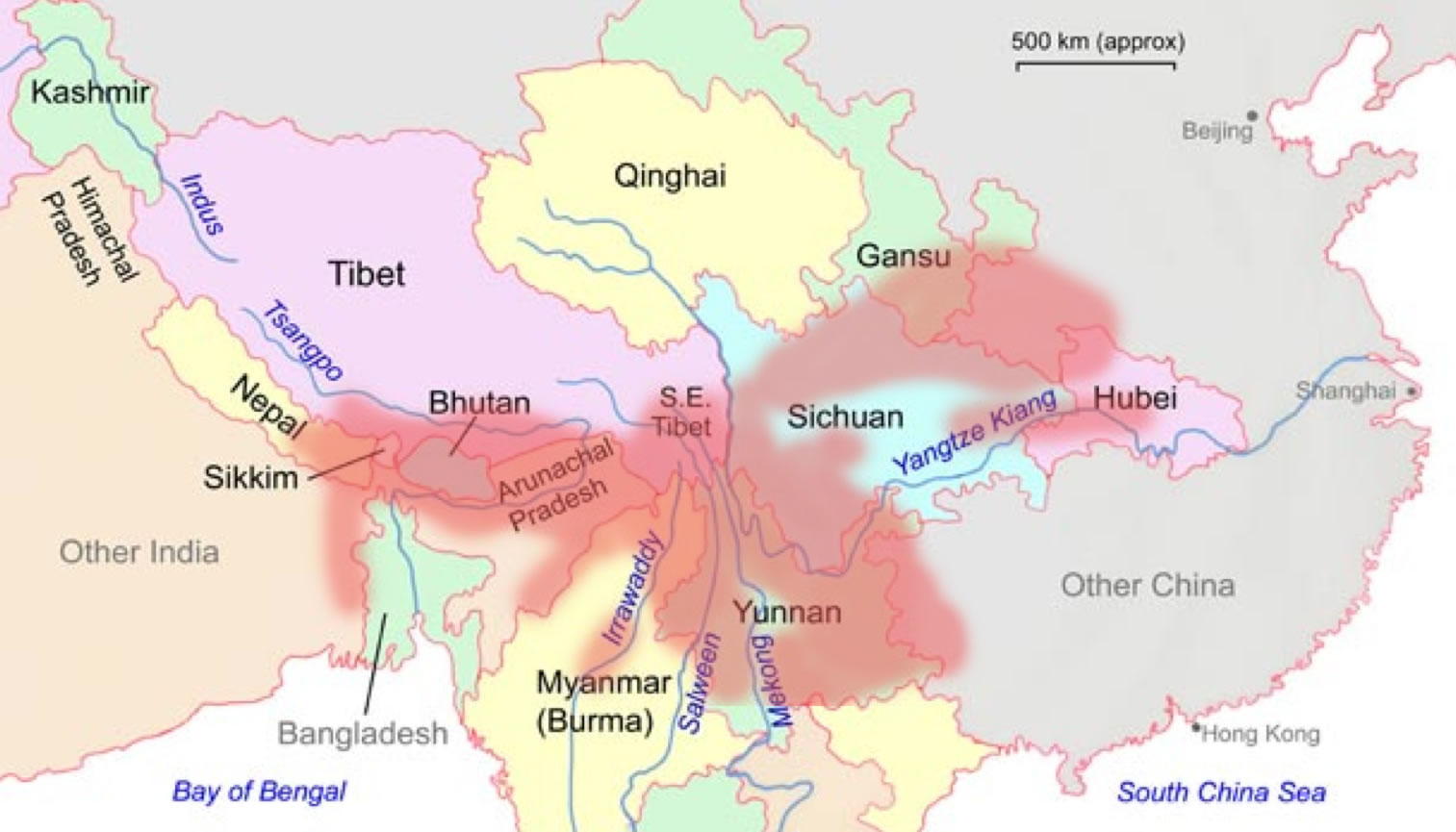
Aside from the vireyas, most lepidote rhododendrons occur in mountainous regions across eastern and southeastern Asia (shown above) and also R. hirsutum, R. ferrugineum, and R. myrtifolium in southern Europe, and R. neoglandulosum in northwestern North America and R. minus in the Appalachian Mountains. An interesting lepidote in the subgenus Rhododendron is Rhododendron lapponicum, which has a circumpolar distribution extending from Lapland across Siberia to northern Canada and into the northern USA. There are also the Labrador teas (R. groenlandicum and R. glandulosum), which are sometimes classified as the genus Ledum and are found from the northern US, through Canada, and into Greenland. Some lepidotes from mountain forests are epiphytic, which means they grow in mossy areas on the higher parts of trees or in mossy areas on rocks.
Examples of Lepidote Rhododendron Species
Subsection Cinnabarina - R. cinnabarinum, R. cinnabarinum purpurellum and R. cinnabarinum ssp. xanthocodon
Subsection Edgeworthia - R. edgeworthii
Subsection Glauca - R. charitopes
Subsection Pogoanthym - R. sargentianum
Subsection Rhododendron - R. hirsutum
Subsection Lapponica - R. fastigiatum, R. impeditum, R. russatum and R. telmateium
Subsection Maddenia - R. ciliatum, R. lindleyi, R. maddenii and R. valentinianum
Subsection Saluenensia - R. calostrotum ssp. riparioides and R. saluenense ssp. saluenense
Subsection Scabrifolia - R. spinuliferum
Subsection Trichoclada - R. caesium
Subsection Trifolia - R. augustinii ssp. augustinii, R. concinnum pseudoyanthinum, R. rigidum and R. triflorum ssp. triflorum
Subsection Cinnabarina
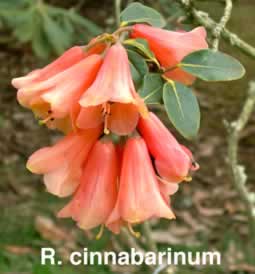 |
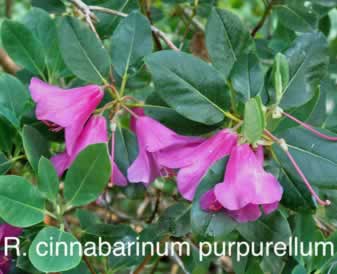 |
 |
Subsection Cinnabarina contains some of the most attractive pendulous flowers in shades of reddish purple, orange, salmon and yellow.
R. cinnabarinum – 3 ft (.9 m), +5°F (-15°C). It has a natural range of colors from red to yellow. It is native from E Nepal through Bhutan to SE Tibet from 7,000 to 13,000 ft (2,130 to 3,960 m).
R. cinnabarinum purpurellum – 3 ft (.9 m), +5°F (-15°C). It is actually part of the xanthocodon subspecies. See its description next.
R. cinnabarinum ssp. xanthocodon – 3 ft (.9 m), +5°F (-15°C). It ranges from yellow to orange to purple. It is native from Arunachal Pradesh through Bhutan to S. Tibet from 10,0000 to 14,000 ft (3,050 to 4,270 m). [Return to Lepidote Rhododendron Species Index]
Subsections Edgeworthia, Glauca, Pogoanthym and Rhododendron
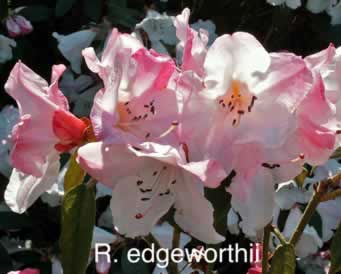 |
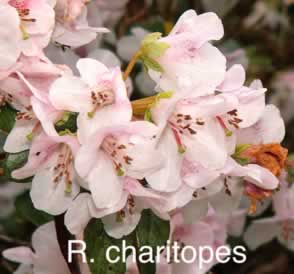 |
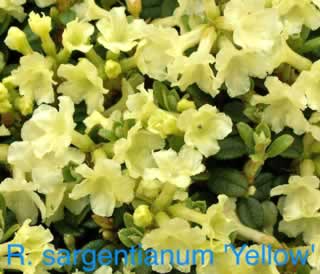 |
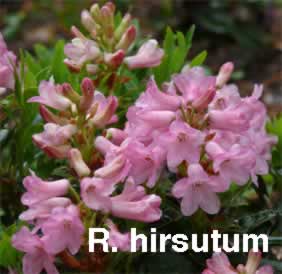 |
Subsection Edgeworthia is characterized by very hairy leaf undersides. They are epiphytes.
R. edgeworthii – 4 ft (1.2 m), +15°F (-10°C). It is semi-dwarf. It is native over a wide area from Sikkim, W Bengal, Arunachal Pradesh & Bhutan to E Burma and Yunnan & S Tibet. Found from 6,000 to 13,000 ft (1,830 to 3,960 m).
Subsection Glauca has bell-shaped flowers in yellow, white, pink and purple. The foliage is aromatic. They are very tender.
R. charitopes – 1 ft (.3 m), 0°F (-18°C). It is low growing with apple-blossom pink flowers. Charitopes is native to a small area of Upper Burma and adjacent N Yunnan from 10,500 to 14,000 ft.
Section Pogonanthym has flowers with distinctive daphne-like flowers and aromatic foliage. They are difficult to hybridize outside their section.
R. sargentianum ‘Yellow' – 1 ft (.3 m), -5°F (-21°C). It is a heavy blooming dwarf species for the rock garden or other sunny locations. It is native only to central Sichuan where it occurs from 10,000 to 14,000 ft (3,050 to 4,270 m) on cliffs and rocks. Has not been collected in the wild since 1904!
Subsection Rhododendron is a group of low-growing European natives. They tend to be hardy and late flowering. They were the first rhododendrons cultivated in European gardens but are not easily grown. Other members include R. ferrugineum and R. myrtifolium.
R. hirsutum – 2 ft (.6 m), -10°F (-23°C). It is a hardy alpine species with hairy foliage. Flowers are in shades of pink or white. It is native limestone soils in mountain terrain limestone areas in the Alps of S Europe from 1,200 to 6,000 ft (370 to 1,830 m). [Return to Lepidote Rhododendron Species Index]
Subsection Lapponica
 |
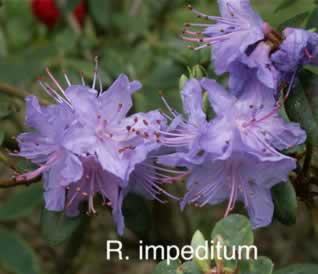 |
 |
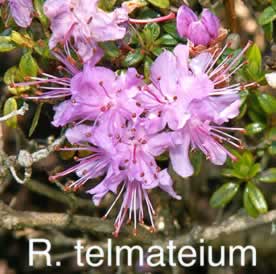 |
Subsection Lapponica is a group of low plants with small leaves and flowers in the purple-blue range. Some are fairly hardy. R. fastigiatum and R. impeditum are among of the hardiest of the group, hardy to -10F. They are both dwarf.
R. fastigiatum – 2 ft (.6 m), -15°F (-26°C). It is very floriferous and relatively easy to grow if provided with good drainage and full sun. It is one of the best lapponicas for all-around garden use. R. fastigiatum is found in open areas of N, NE, & C Yunnan.
R. impeditum – 1 ft (.3 m), -15°F (-26°C). It is one of the more adaptable and hardy of the “alpine” species and is excellent for the rock garden. It is common in various sub-alpine and alpine habitats. It is found in N Yunnan and SW Sichuan in various sub-alpine and alpine habitats.
R. russatum – 3 ft (.9 m), -10°F (-23°C). It is a semi-dwarf with shades of blue-purple, purple, lavender and reddish purple. It is found in N & NW Yunnan to SW Sichuan from 11,000 ft. to 14,000 ft (3,350 to 4,270 m).
R. telmateium – 1 ft (.3 m), -10°F (-23°C). It is very dwarf member of the lapponica Subsection. It is rare in cultivation. It is native to various alpine habitats from 9,500 to 16,000 ft (2,750 to 4,870 m) in N Yunnan and adjacent SW Sichuan. [Return to Lepidote Rhododendron Species Index]
Subsection Maddenia is mostly fragrant and tender plants that can grow fairly tall. They are epiphytic plants.
R. ciliatum – 3 ft (.9 m), +5°F (-15°C). It is a parent of Dora Amateis and other dwarf hybrids. R. ciliatum is native to E Nepal, Sikkim, Bhutan, S Tibet from 8,000 to 13,000 ft (2,430 to 3,960 m).
R. lindleyi – 5 ft (1.5 m), +20°F (-7°C). It is large and fragrant. They vary from pure white to pink. They are rated by many as having the most beautiful flowers in the genus. Lindleyi occurs as an epiphyte or on cliffs from E Nepal to SE Tibet from 6,000 to 11,000 ft (1,830 to 3,350 m).
R. maddenii – 4 ft (1.2 m), +10°F (-12°C). It grows up to 30 ft. tall. It has large fragrant flowers that are extremely variable, usually white. R. maddenii is native to W Arunachal Pradesh, Bhutan, and Sikkim from 5,000 to 12,000 ft (1,530 to 3,660 m).
R. valentinianum – 2 ft (.6 m), +10°F (-12°C). It has yellow flowers on a tender shrub. Valentinianum is found growing on cliffs and stony slopes from 9,000 to 12,000 ft (2,740 to 3,660 m). NE Burma & Yunnan Frontier. [Return to Lepidote Rhododendron Species Index]
Subsections Saluenensia, Scabrifolia and Trichoclada
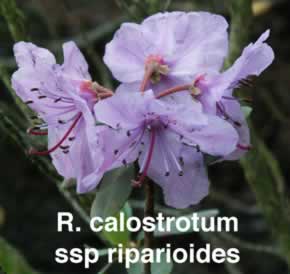 |
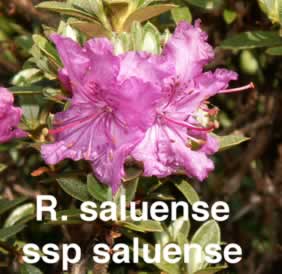 |
 |
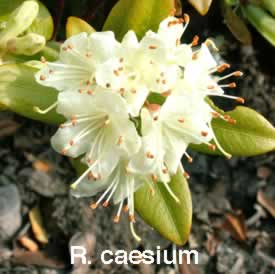 |
Subsection Saluenensia is prostrate plant with purple, pink or reddish flowers.
R. calostrotum ssp. riparioides – 2 ft (.6 m), 0°F (-18°C). It has blue-green leaves and larger flowers that are generally more purple or blue-purple than reddish purple. Calostrotum ssp. riparioides is only known from a small area of W Yunnan near Weixi where it grows on alpine slopes and cliffs from 12,000 to 13,500 ft (3,660 to 4,110 m).
R. saluenense ssp. saluenense – 2 ft (.6 m), -5°F (-21°C). It is tolerant of sun but requires excellent drainage. It is native to SE Tibet, NE Burma and NW Yunnan, China where they occur from 11,000 to 14,000 ft (3,350 to 4,270 m) in various alpine habitats.
Subsection Scabrifolia has clusters of pink to reddish flowers growing from axillary buds.
R. spinuliferum – 4 ft (1.2 m), +5°F (-15°C). It is an upright plant with attractive leaves with prominent veining. However, it is best known for its strange upright tubular flowers. They range in color from pink to crimson with protruding stamens and style. Spinuliferum is native to Yunnan and S Sichuan where it occurs in dry pine forests and thickets from 5,500 to 8,500 ft (1,680 to 2,590 m).
Subsection Trichoclada is a group of yellow-flowered species. Some are deciduous and flower on bare stems.
R. caesium – 3 ft (.9 m), 0°F (-18°C). It is semi-evergreen and tender. It is compact and has aromatic foliage. Caesium is native to the western Yunnan where it occurs from 8,000 to 10,000 ft (2,430 to 3,050 m). on rocky slopes. [Return to Lepidote Rhododendron Species Index]
Subsection Trifolia
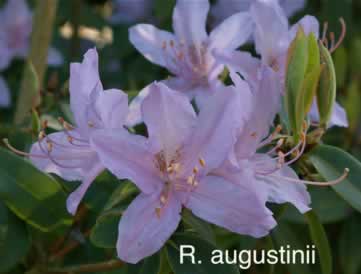 |
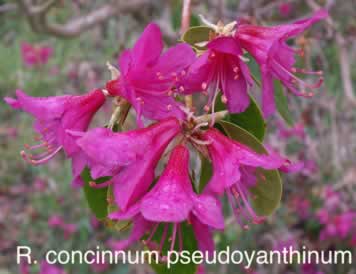 |
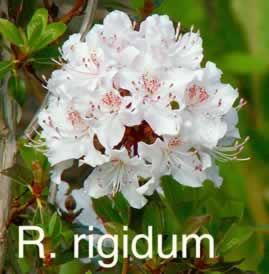 |
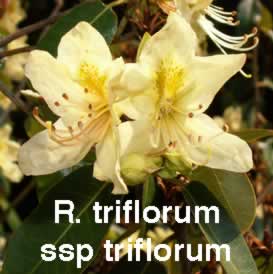 |
Subsection Trifolia is a group of vigorous plants.
R. augustinii ssp. augustinii – 6 ft (1.8 m), 0°F (-18°C). It is well known for its blue forms, which are quite spectacular. Augustinii ssp. augustinii is native to China (Hubei & Sichuan) in various open situations from 4,000 to 11,000 ft (1,220 to 3,350 m).
R. concinnum pseudoyanthinum – 5 ft (1.5 m), -5°F (-21°C). It has ruby red flowers. It is native from W Sichuan into C China.
R. rigidum – 6 ft (1.8 m), 0°F (-18°C). It has flowers that are white to rose-lavender. Rigidum is native to N Yunnan and S Sichuan, China where it occurs in a wide variety of habitats from 2,500 to 11,000 ft (770 to 3,350 m).
R. triflorum ssp. triflorum – 6 ft (1.8 m), +5°F (-15°C). It has flowers that are cream to various shades of yellow, with greenish spots. It has attractive peeling bark. Triflorum ssp. triflorum is native in the eastern Himalayas from E Nepal into the N Burma/SE Tibet frontier. It occurs in a wide variety of habitats from 7,000 to 13,000 ft (2,130 to 3,960 m). [Return to Lepidote Rhododendron Species Index]
How To Grow Rhododendron Species
Rhododendrons grow best in partial shade, since full sunlight tends to bleach the flowers. They need an acid soil with a pH of 5.0 to 6.0, well mulched with organic material. Mix garden loam with equal parts of coarse sand and ground bark or oak leaves before planting. Soil around the rhododendrons' shallow roots must be kept cool and moist but well drained. All except leather-leaf rhododendrons transplant well in the spring, or in the fall if mild winter weather does not damage the shallow-rooted plants. Do not fertilize at the time of planting, as this might injure the roots, but water deeply. Supplemental feeding later is not normally needed, but if a plant appears pale or droopy, apply cottonseed meal or a fertilizer for acid-loving plants around its base in early spring. A year-round mulch of rotted oak leaves will also provide natural nutrients and will help keep the soil cool and moist.
Prune rhododendrons after the flowers have faded to induce new growth. Most evergreen rhododendrons may be propagated from stem cuttings of new growth taken in late summer and rooted in a mixture of perlite or vermiculite and peat moss. Deciduous rhododendrons are propagated by seed, grafting or cuttings. For deciduous azaleas, cuttings may need bottom warmth of 75° and artificial light to promote root growth.
Do not cultivate around the shallow roots of rhododendrons and azaleas, but pinch off their faded flowers to improve bloom the following year. Also, prune out dead, diseased or damaged branches, and cut old branches back to the soil level to encourage new growth.
References
- Bell, H. T., & Clarke, R. G. (1978). Resistance among Rhododendron species to obscure root weevil feeding. Journal of Economic Entomology, 71(6), 869-870.
- Church, Glyn and Graham Smith, & Pat Greenfield (2015). Big-Leaf Rhododendrons: Growing the Giants of the Genus.
- Cowan, John Macqueen (1950). The Rhododendron Leaf: A Study of the Epidermal Appendages.
- Cox, Kenneth (2005). Rhododendrons & Azaleas, A Colour Guide. The Crowood Press.
- Cox, Peter & Cox, Kenneth (1997). Encyclopedia of Rhododendron Species. Glendoick Publishing.
- Desch, C. (1983). The Rhododendron leaf scale. Journal American Rhododendron Society, 37(2), 78-80. link
- Dome, A. P. (1999). Those Exciting Rhododendron Epidermal Appendages Journal American Rhododendron Society, 53(4), 198-200. link
- Doss, R. P. (1982). Chemicals from Rhododendrons act as weevil repellents. Journal American Rhododendron Society, 36(3), 103. link
- Greer, Harold E. (1996). Greer's Guidebook To Available Rhododendrons. Offshoot Publications.
- Nilsen, E. T., Webb, D. W., & Bao, Z. (2014). The function of foliar scales in water conservation: an evaluation using tropical-mountain , evergreen shrubs of the species Rhododendron in section Schistanthe ( Ericaceae ). Australian Journal of Botany, 62(5), 403-416.
- Salley, Homer & Greer, Harold (1986). Rhododendron Hybrids – A Guide To Their Origins. Timber Press.
- Scott-Brown, A. S., Gregory, T., Farrell, I. W., & Stevenson, P. C. (2016). Leaf trichomes and foliar chemistry mediate defence against glasshouse thrips; Heliothrips haemorrhoidalis (Bouché) in Rhododendron simsii. Functional Plant Biology, 43(12), 1170-1182. link
- Spady, H., & Averill, S. J. (1984). Scanning electron microscopy of trichomes. Rhododendron Notes and Records (J. RSF), 1, 65-72.
